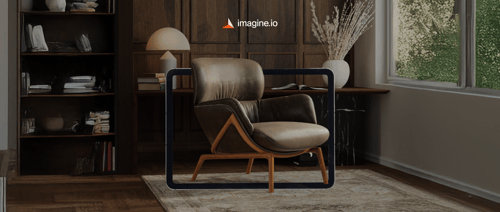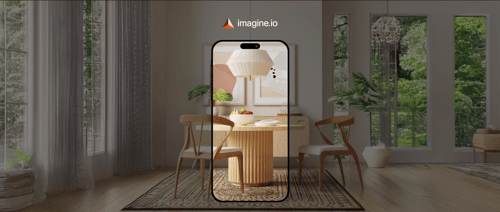Quick Listen:
Imagine shopping online for a new armchair, but instead of relying on static, uninspiring photos, you're rotating a vivid 3D model, switching fabrics, and placing it in a virtual replica of your living room. This isn't a futuristic fantasy it's the cutting-edge reality of e-commerce in 2025. Tools powered by augmented reality (AR) and 3D visualization are handing shoppers the reins, transforming passive browsing into a dynamic, hands-on experience. Platforms like imagine.io are leading this charge, enabling consumers to tweak, visualize, and personalize products in real time. What's fueling this revolution, and how will it reshape the future of retail?
The hunger for personalized shopping experiences has exploded, driven by consumers who demand products tailored to their precise tastes. According to a Global Growth Insights report, the global market for 3D product visualization platforms was valued at $343.18 million in 2024, set to reach $435.91 million in 2025 and soar to $2,953.44 million by 2033, propelled by a robust 27.02% compound annual growth rate (CAGR). The reason? Shoppers crave more than flat images they want photorealistic, interactive views of products, customized to their specifications. These platforms, leveraging AR, virtual reality (VR), and real-time rendering, boost e-commerce engagement by 65% and enable 78% of users to make quicker purchasing decisions.
This technology isn't just eye-catching it builds confidence. When you can spin a pair of sunglasses, adjust their frame color, or see them on your face via AR, you're far more likely to click “add to cart.” The data supports this: 52% of businesses surveyed reported enhanced customer satisfaction due to these visualization tools. Industries like retail, real estate, and automotive are early adopters, but the impact spans fashion, furniture, and beyond. imagine.io has carved a niche by empowering brands to deliver these immersive experiences, allowing shoppers to act as co-designers from their screens.
Empowering Shoppers to Take Control
The rise of user-driven customization reflects a seismic shift in consumer expectations: buyers want to call the shots. The era of one-size-fits-all products is fading. A Market Research Future report estimates the product configurator market at $2.32 billion in 2024, projected to climb to $5.16 billion by 2032 with a 10.5% CAGR. These tools allow consumers to personalize everything from car interiors to kitchen appliances, visualizing changes in 2D, 3D, or AR. The outcome? Products that feel uniquely crafted, even when produced at scale.
In fashion, imagine.io's technology lets shoppers alter a coat's material or swap its buttons, seeing the results instantly. This interactivity isn't just engaging it's practical, driving higher conversion rates and fewer returns. The home décor sector is similarly transformed. Furniture retailers use AR to let customers “place” a sofa in their living room, adjusting its size or fabric. Businesses adopting these tools report not only happier customers but also streamlined operations, with reduced errors in inventory and production.
Tangible Success Stories
The furniture industry, plagued by high return rates, offers a compelling case. A leading retailer partnered with imagine.io to deploy AR-powered visualization. Shoppers could visualize a dining table in their home, tweaking its finish or size in real time. The result? A 30% reduction in returns and a notable sales increase, as buyers felt more certain of their purchases. In fashion, a high-end brand leveraged imagine.io's platform to let customers design custom handbags, selecting leathers and hardware in 3D. Engagement surged, with users spending 40% more time on the site and conversion rates rising significantly.
These examples are part of a broader trend. The visual product customization software market, valued at $1.2 billion in 2024, is expected to reach $3.5 billion by 2033, growing at a 14.5% CAGR. Advances in 3D visualization, AR, and artificial intelligence (AI) are making these platforms more intuitive, enhancing user engagement and satisfaction. For businesses, the benefits are undeniable: stronger customer loyalty, fewer mistakes, and a sharper competitive edge in crowded markets.
Navigating the Challenges
Yet, the path to widespread adoption isn't without obstacles. Rendering high-fidelity visuals in real time requires substantial computing power, and not all consumers own AR-compatible devices or high-end smartphones. Compatibility issues can frustrate users, while the learning curve for interactive features may deter some, particularly older shoppers who might view the tech as overly complex or irrelevant for basic purchases.
Cost is another hurdle. Developing seamless 3D and AR experiences demands significant investment in software, skilled personnel, and infrastructure. Smaller retailers, in particular, may balk at the upfront expense, even with the promise of long-term gains. Technical glitches slow rendering, clunky interfaces can also erode the trust these tools aim to foster, turning a potential win into a liability.
Seizing the Opportunities
Despite these challenges, the potential is vast. Customization doesn't merely sell products it forges connections. By inviting customers to design their own shoes or preview a couch in their home, brands create a sense of ownership that breeds loyalty. The data is clear: interactive product views boost purchase confidence, reducing cart abandonment and driving sales.
Operationally, the benefits are equally compelling. Virtual “try-before-you-buy” experiences cut return rates, a significant cost in e-commerce. Real-time feedback from customization tools accelerates product development, enabling brands to identify trends and refine designs swiftly. Improved inventory management rounds out the advantages, making these technologies a strategic imperative for forward-thinking companies.
Charting the Future
For businesses, the roadmap is straightforward but demanding. Begin modestly, perhaps with a single product category, and prioritize intuitive user experiences poorly designed interfaces can alienate customers faster than high prices. Collaborate with established platforms like imagine.io to leverage proven solutions. Rigorous testing is critical; a faulty AR tool can do more harm than good. While the initial investment may be steep, the rewards higher sales, loyal customers, and operational efficiencies are transformative.
A New Era of Retail
Reflecting on this shift, it's remarkable how far e-commerce has evolved. Online shopping once meant hoping a product matched its thumbnail image. Today, a few clicks let you design, visualize, and virtually test your purchase. This isn't just commerce it's creation. The future of retail lies in this promise: every product can feel like it was crafted just for you. As brands embrace user-driven customization, they're not only meeting consumer demands they're redefining what it means to shop.
Disclaimer: The above helpful resources content contains personal opinions and experiences. The information provided is for general knowledge and does not constitute professional advice.
You may also be interested in: imagine.io | Award Winning 3D + AI Product Visualization
Struggling with expensive, outdated product visuals that slow down your creative process and stunt eCommerce growth? imagine.io's AI-powered platform empowers furniture, home décor, and textile brands to effortlessly produce striking 3D images, immersive videos, AR experiences, and interactive configurators. Cut production costs up to 70%, boost conversions 5X, speed up prototyping, and supercharge your online sales. Ready to elevate your product visuals and captivate customers? Book a demo with imagine.io today!
Powered by flareAI.co




.png?width=500&name=How%20to%20Add%20a%203D%20Product%20Configurator%20to%20Your%20WordPress%20Website%20(Complete%20B2B%20Guide).png)
















%20(1).png?width=500&name=Why%20Exploded%20Mattress%20Views%20Matter%20(And%20How%20to%20Generate%20Them)%20(1).png)
.png?width=500&name=Best%20Shopify%20Product%20Configurator_%20How%20to%20Choose%20the%20Right%20One%20(2).png)
.png?width=500&name=Why%20Exploded%20Mattress%20Views%20Matter%20(And%20How%20to%20Generate%20Them).png)



.png?width=500&name=Best%20Shopify%20Product%20Configurator_%20How%20to%20Choose%20the%20Right%20One%20(1).png)







.png?width=500&name=How%203D%20Rendering%20Can%20Make%20or%20Break%20Your%20Industrial%20Design%20Pitch%20(1).png)








%20with%20Digital%20Twins%20and%203D%20Visualization.png?width=500&name=Optimizing%20Your%20Digital%20Asset%20Management%20(DAM)%20with%20Digital%20Twins%20and%203D%20Visualization.png)




.png?width=500&name=Styling%20Home%20Decor%20for%202025_%20From%20Global%20Influences%20to%20Playful%20Personalization%20(1).png)
